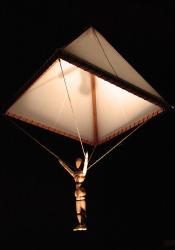Parachute
The first practical device that demonstrated the principle of parachuting was developed by Sebastien Lenormand in 1783. Jean Pierre Blanchard actually created the first parachute in 1785, while Jacques Garnerin was able to make a successful descent with a parachute from 3,000 feet in 1797. All of these iterations were steps towards the modern parachute of today, used by both the military and recreational users- for safety and for fun. The origin of all of this was in Leonardo da Vinci’s parachute design comprised of sealed lined cloth held by assorted wooden poles. In his notebooks, next to his original parachute design, were the words "If a man is provided with a length of gummed linen cloth with a length of 12 yards on each side and 12 yards high, he can jump from any great height whatsoever without injury." This parachute was particularly of note because it had a triangular canopy rather than a rounded one. Modern scientists were skeptical of da Vinci’s parachute being able float, until Adrian Nicholas tested a prototype built to da Vinci’s specifications at 3,000 feet in 2000 and proved it to be successful.
Sources:
“Parachute.” Leonardo Da Vinci's Parachute Invention, 2008, http://www.da-vinci-inventions.com/parachute.aspx.
“DaVinci's Parachute.” Flying out of This World, 2008, www.flyingoutofthisworld.blogspot.com/2008/02/davincis-parachute.html.
Image Source : Permission granted to share this work by Nevit Dilmen under the terms of the GNU Free Documentation License (https://commons.wikimedia.org/wiki/File:Leonardo_da_Vinci_parachute_0465...), "Leonardo da Vinci parachute 04659a", https://creativecommons.org/licenses/by-sa/3.0/legalcode

